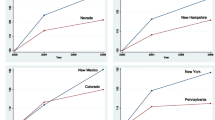Abstract
The relationship between AFDC, Food Stamp, and Medi-Cal Program eligibility, on the one hand, and labor force participation, on the other, was analyzed by comparing the labor force participation rates of women of Mexican origin who were ‘fully eligible’ for these programs with those of ‘less eligible’ women. Marital status, husband's income, and legal residence in the United States were used to define levels of program eligibility for this sample. The effects of education, English fluency, age, the number and ages of children, and the number of other adults in the household (excluding the mother and spouse) were controlled in logistic regression procedures. The results of the multivariate analyses show that AFDC, food stamps, and Medi-Cal combined inhibit the labor force participation of unmarried mothers. There is no evidence, however, that food stamps and Medi-Cal influence the labor force participation of married mothers. Earnings information on this sample of California women indicate that welfare benefits for unmarried mothers are highly competitive with net earnings, primarily because of the cost childcare. The data imply that free or subsidized childcare would increase labor force participation and reduce AFDC enrollment.
Similar content being viewed by others
References
Anderson, M. (1978). The Political Economy of Welfare Reform in the United States. Stanford: Hoover Institution Press.
Barr, N. and R. Hall (1981). ‘The Probability of Dependency on Public Assistance,’ Economica, 48: 109–123.
Bowen, W. and T. Finegan (1969). The Economics of Labor Force Participation. Princeton: Princeton University Press.
Committee on Ways and Means, U.S. House of Representatives (1985). ‘Background Material on Programs within the Jurisdiction of the Committee on Ways and Means.’ February, 1985.
Cooney, R. (1975). ‘Changing Labor Force Participation of Mexican American Wives: A Comparison with Anglos and Blacks,’ Social Science Quarterly, 56: 252–261.
Danziger, S., R. Haveman, and R. Plotnick (1981). ‘How Income Transfer Programs Affect Work, Savings and Income Distributions: A Critical Review,’ Journal of Economic Literature, 19: 975–1028.
Garfinkel, I. and L. Orr (1974). ‘Welfare Policy and Employment Rates of AFDC Mothers,’ National Tax Journal, 27: 275–84.
Hausman, J. (1980). ‘The Effects of Wages, Taxes, and Fixed Costs on Female Labor Force Participation,’ Journal of Public Economics, 14: 161–194.
Hausman, J. (1981). ‘Labor Supply,’ in H. Aaron and J. Pleckman (eds.), How Taxes Affect Economic Behavior. Washington, D.C.: Brookings Institution.
Heer, D.M. and J. Passel (1985). ‘Comparison of Two Different Methods for Computing the Number of Undocumented Mexican Adults in the Los Angeles PMSA.’ Paper presented at the Annual Meetings of the Population Association of America, Boston, MA, March 18–21.
Krashinsky, M. (1975). ‘Day Care and Welfare,’ in I. Lurie (ed.), Integrating Income Maintenance Programs. New York: Academic Press.
Levy, F. (1979). ‘The Labor Supply of Female Household Heads, or AFDC Work Incentives Don't Work Too Well,’ Journal of Human Resources, 14: 76–97.
Masters, S. and I. Garfinkel (1977). Estimating the Labor Supply Effects of Income Maintenance Alternatives. New York: Academic Press.
Oppenheimer, V. (1970). The Female Labor Force in the United States. Westport, Conn.: Greenwood Press.
Oppenheimer, V. (1982). Work and the Family: A Study in Social Demography. New York: Academic Press.
Robins, P., R. Spiegelman, and S. Weiner (1980). A Guaranteed Annual Income: Evidence from a Social Experiment. New York: Academic Press.
Robinson, L. (1982). ‘Statement of Testimony Concerning AFDC,’ heard before the Subcommittee on Public Assistance and Unemployment Compensation, Committee on Ways and Means, U.S. House of Representatives, June 23.
Saks, D. (1975). Public Assistance for Mothers in an Urban Labor Market. Princeton: Industrial Relations Section, Princeton University.
Segalman, R. and Basu, A. (1981). Poverty in America. Westport, Conn.: Greenwood Press.
U.S. Department of Health and Human Services. (1981). Characteristics of States Plans for Aid to Families with Dependent Children Under the Social Security Act, Title IV-A. Washington, D.C.: U.S. Government Printing Office. Research Tables, pp. 77–78.
Williams, R. (1975). Public Assistance and Work Effort. Princeton: Industrial Relations Section, Princeton University.
Wishnov, B. (1973). Determinants of the Work-Welfare Choice: A Study of AFDC Women. Boston: Boston College, Social Welfare Regional Research Center.
Author information
Authors and Affiliations
Rights and permissions
About this article
Cite this article
Hancock, P. The effect of welfare eligibility on the labor force participation of women of Mexican origin in California. Popul Res Policy Rev 5, 163–185 (1986). https://doi.org/10.1007/BF00137179
Issue Date:
DOI: https://doi.org/10.1007/BF00137179




